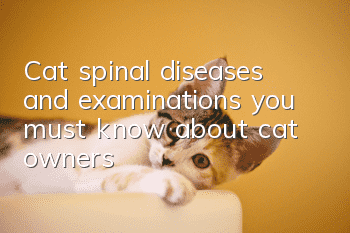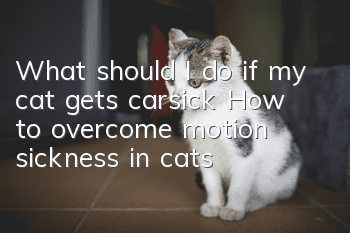Cat spinal diseases and examinations, you must know about cat owners!

Falling injuries may cause damage to the spine
Cat spinal diseases and examinations, you must understand as a cat owner! Due to stunted development or accidental falls, cats’ spinal diseases are becoming more and more common. more. The symptoms of spinal diseases are diverse, ranging from mild, self-healing paroxysmal pain and movement restriction, to progressive, fatal paralysis, convulsions and even shock, which may occur clinically and are easily associated with peripheral joint muscle lesions. , thoracic and abdominal tumors, pancreatitis, nerve damage from infectious diseases, etc.; and the condition develops and changes very quickly, often qualitative leaps can occur within hours or days, such as from mild pain to paralysis, from hind limb nerve disorders to Total limb paralysis, even from paraparesis to respiratory failure and death.
1. Spondylitis and myelitis
1. Symptoms: stiff neck, stiff back, increased body temperature, unexplained weight loss, difficulty in walking, muscle tenderness< /p>
2. Disease definition: Spondylitis is an infection of the intervertebral disc and adjacent spine. Myelitis is simply inflammation of the spinal cord.
3. Cause: Most cases are caused by bacteria. Staphylococci are the most common source of microbial infections. Brucella. Streptococcus, Pseudomonas, Escherichia coli. Pasteurella spp. and other bacteria. Fungal infections are relatively rare. Aspergillus, Coccidioides. The entry of plant thorns can cause secondary infection of actinomycetes, which can cause osteomyelitis of the spine, especially the spine of the waist.
4. Symptom description: Hyperalgesia in the lesion is the most common symptom. A stilt gait, hunched back, or neck stiffness may occur. Systemic changes can occur, including fever, depression, and weight loss. Neurological symptoms vary between ataxia and paralysis of the tail. Lesions may occur in multiple locations.
5. Disease treatment: Antibiotic drugs are selected based on the results of culture and drug sensitivity tests. If no bacteria can be isolated, staphylococci are assumed to be the cause. Cephalosporins 20 mg/kg orally, 3 times a day, or cloxacillin 10 mg/kg orally can be given. 4 times a day. If there is no response within 5 days. Reevaluate therapy, or consider surgery. Antibiotic administration is continued for at least 6 weeks. For spondylodiscitis caused by brucellosis, consider taking the following measures: enrofloxacin 5 to 15 mg/kg orally, twice a day; minocycline (minocycline) 12 mg/kg orally, once a day Twice a day, and gentamicin 2.2 mg/kg, intramuscular injection, three times a day. Rest until symptoms subside.
When antibiotics fail to cure, surgical curettage of the affected intervertebral space and culture of the tissue is necessary for surveillance.
2. Spinal deformity
1. Definition
Congenital deformity of more than one spine. Types of spinal deformities ① Hemivertebral deformity: The wedge-shaped vertebral base faces the back, abdomen, or in the middle. ② Obstruction of the spine: The adjacent spine is partially or completely dissolved. ③ Butterfly plate spine: split in the sagittal plane of the spine. ④Transforming spine: Occurs at the junction of the main divisions of the spine and is characterized by 2 types of spine. For example, the lumbar and sacral changing spine has the characteristics of the lumbar and sacral spine.
2. Cause:
Usually unknown, in some cases hereditary.
3. Symptom description:
Most spinal deformities are not related to clinical symptoms, but are discovered accidentally on X-ray films. Hemivertebral deformity is the most common deformity causing clinical symptoms. Neurohistological lesions are associated with myelopathic lesions. Onset is usually but not always seen in immature animals. As the animal grows, symptoms can develop.
3. Diagnosis of spinal diseases
1. Physical examination
Including age, gender, breed and type of daily activities. When used in conjunction with the history, physical examination, and neurological examination, physical description can provide important information in defining the type of spondylosis and deciding what diagnostic protocol to develop.
2. Medical history
Record in detail the owner’s description of the occurrence and development of clinical symptoms. These records can affect the content of differential diagnosis and the diagnostic plan. Neurological symptoms of acute onset and rapid development are often associated with trauma, infectious disease, or acute inflammatory injury. In these cases, clinical symptoms generally reach a climax within 2 to 48 hours, and recovery is slower than the onset of the disease. Slower. Neurological symptoms that develop more slowly are often associated with degenerative diseases or tumors. The development of clinical symptoms often lasts for weeks or months, and although there are brief relapses during this period, the overall clinical symptoms will worsen over time. Failure to develop neurological symptoms may suggest a congenital disorder. This correlation is only indicative and not absolute. For example, spinal cord tumors can also cause acute onset of clinical symptoms. In addition, the previous diagnosis results of similar symptoms in sick animals and the time interval between this onset and the last onset also have some reference significance.
3. Physical examination
The primary purpose of physical examination of cats suspected of suffering from spinal disease is to rule out diseases that are easily confused with spinal disease. Pain, immobility (paresis or paralysis), weakness, and gait abnormalities are common symptoms in spinal, musculoskeletal, peripheral neuromuscular, or metabolic diseases. Some metabolic, cardiovascular, and musculoskeletal diseases have clinical manifestations similar to neurological diseases. Attributing pain from lumbosacral disease to osteoarthritis of the hip is a common example of misdiagnosing spinal problems as musculoskeletal problems. If lumbosacral disease goes undiagnosed, it can have serious adverse consequences for sick cats. . An example of a musculoskeletal problem being misdiagnosed as a neurological disorder is bilateral anterior cruciate ligament rupture.
- How to educate Abyssinian cats when they make mistakes
- Can having a cat help relieve depression?
- How to care for newborn cats
- What's wrong with the cat not eating?
- Why do cats’ nails crack when they are cut?
- Can cats with oral herpes eat?
- Can Ragdoll cats eat rice?
- How to clear blocked nasolacrimal ducts in cats
- Cats need to be hungry for several days before they are willing to eat cat food
- Cat's toes have black scabs on them



